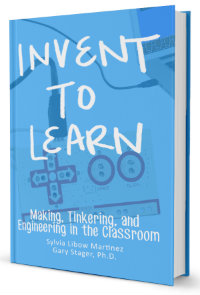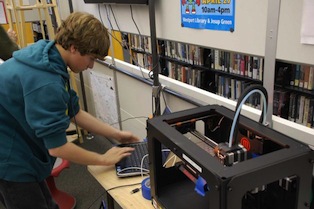Everything You Need to Become a Maker School
Invent to Learn: Making, Tinkering and Engineering in the Classroom
By Sylvia Libow Martinez and Gary Stager
(Constructing Modern Knowledge Press, 2013 – Learn more)
Whatever your view of standardized testing, there can be little argument that the move towards academic rigor has stifled the culture of creative tinkering in many classrooms. Teachers seem to be losing the wiggle room needed for long-term, hands-on projects as test scores put downward pressure on all classrooms.
In Invent to Learn, writers Sylvia Libow Martinez (an engineer turned educator) and Gary Stager (a teacher and early proponent of online and 1-to-1 learning) make a strong case to bring the excitement and passion of the emerging Maker’s Movement into our schools and help kids get their hands dirty and their minds engaged through the act of creating things.
Martinez and Stager balance their argument with both a history of the constructivist theory of learning (we learn by doing and when we do, we invent) and an articulate case for making education more relevant for students who are tuning out the drill-and-kill methods used in many schools.
 There are plenty of noteworthy passages from the book, but this piece captures the theme, in my mind: they write, When we allow children to experiment, take risks, and play with their own ideas, we give them permission to trust themselves. They begin to see themselves as learners who have good ideas and can transform their own ideas into reality.
There are plenty of noteworthy passages from the book, but this piece captures the theme, in my mind: they write, When we allow children to experiment, take risks, and play with their own ideas, we give them permission to trust themselves. They begin to see themselves as learners who have good ideas and can transform their own ideas into reality.
Turning learning on its head
Martinez and Stager situate Invent to Learn by giving a brief history of the Maker Movement, tying the tenets of iterative design and engaged learning in physical spaces that value thoughtful invention to real world applications around collaboration, engineering ideas and learning that comes from reflective practice.
Certainly, technology innovations are opening up doors to engineering possibilities that were never before possible, and they note three “reversals” brought on by technology worth noting: young people are following their passions for learning in online spaces (such as YouTube) that are outside our traditional learning environments; the lowering cost of computers puts technology in the hands of the “learner” not the “teacher”; and technology allows even young children to be exposed to powerful ideas in ways that are understandable.
Plenty of practical ideas and help for teachers
This book is written with the classroom teacher in mind, offering lots of practical advice on how to think about tinkering and how to view the role of the teacher in a student-centered classroom (essentially, less of us teachers and more of the students in all aspects of the learning).
The book shifts from theory to practicality pretty quickly, too, and soon we are learning about specific projects, from the advanced possibilities of 3D printers, to a form of modeling clay that can be programmed to do things via the computer, to re-using existing supplies to create “Maker” projects. Even cardboard boxes have a role in this view of learning. The tone of the writing is engaging, making it easy for even the most reluctant hands-on teacher to consider the possibilities of developing some version of what Stager and Martinez call “the Fab Lab.”
 One particular chapter seemed like a gift to the reader. Here, the writers “make the case” for the idea of a Maker Space/Fab Lab in the schools. While they acknowledge that there will be all sorts of pressures (standardized testing, budget woes, etc.), they map out not only questions that will likely be raised if you were to launch into making a Maker Space in your school, but also possible responses. They also list suggested talking points when approaching administrators or School Committees about the idea.
One particular chapter seemed like a gift to the reader. Here, the writers “make the case” for the idea of a Maker Space/Fab Lab in the schools. While they acknowledge that there will be all sorts of pressures (standardized testing, budget woes, etc.), they map out not only questions that will likely be raised if you were to launch into making a Maker Space in your school, but also possible responses. They also list suggested talking points when approaching administrators or School Committees about the idea.
Even if you don’t see your school setting aside money and space for a large-scale program for young inventors and engineers, Martinez and Stager show how you could host a Maker’s Fair as an event at your school. You’ll find information about who to contact, how to organize your first Fair, how to publicize your event, and most important, how to make sure students are at the center of it all – at all times. Which, ultimately, is the goal of any learning initiative, particularly one where we hope our students’ hands (and fingers) get a bit dirty.
Kevin Hodgson is a sixth grade teacher at William E. Norris Elementary in Southampton MA and technology liaison for the Western Massachusetts Writing Project. A former newspaper journalist and aspiring writer himself, Kevin believes in the idea that all students are writers and that writing is one of the most fundamental means of understanding the world. His views around literacy include interaction within the digital world, meeting students on common ground and helping them make the shift from passive consumers to active creators and collaborators. He is a co-editor of Teaching the New Writing: Technology, Change and Assessment in the 21st Century and blogs regularly at Kevin’s Meandering Mind. He can also be found on Twitter as @dogtrax.
ALSO SEE: Sylvia Libow Martinez and Gary Stager wrote a post for Anne Jolly’s MiddleWeb STEM blog titled “Classroom Tinkers and Inventors.”


































